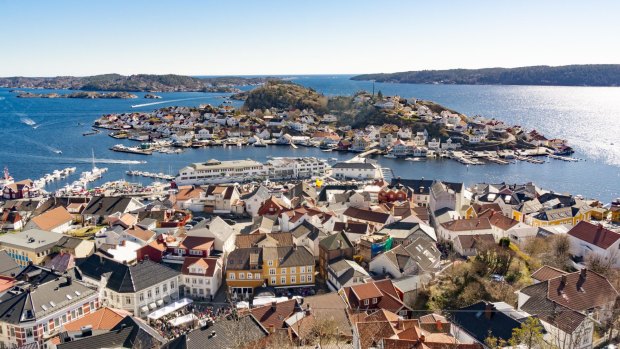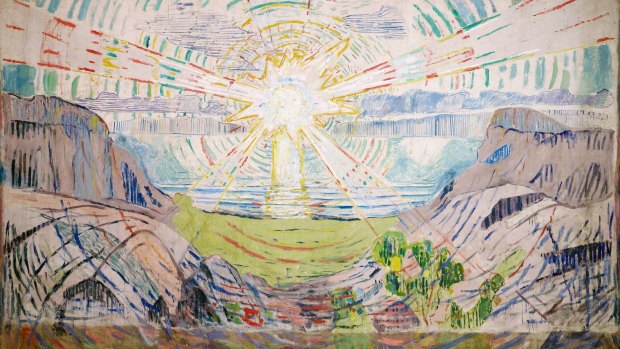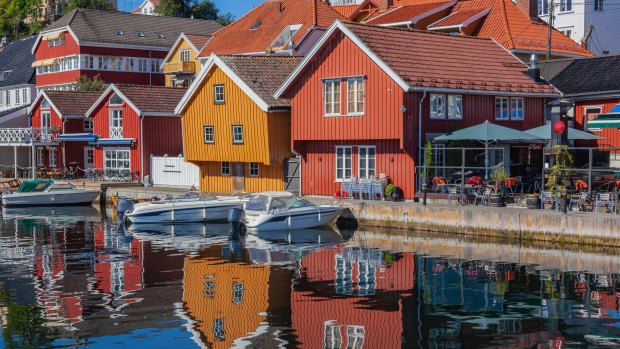This was published 5 years ago
Kragero, Norway travel guide: Beloved by artist Evard Munch, for art, wildlife and spectacular scenery
By Alison Stewart

Kragero, on the edge of the 490-island Kragero archipelago, is a popular summer holiday getaway 194 kilometres from Oslo.Credit: Shutterstock
When the sun strengthens and the days lengthen, Oslo's getaway-loving residents have a hankering for Kragero's "light". One of Norway's most famous names also sought out the seaside town for its inspirational light – the painter Edvard Munch.
Many travellers to Norway are on the hunt for that red, green and purple pulsating, crackling veil of light known by many names, including aurora borealis, Northern Lights, Green Lady, Fox's Fur or, in the Sami language, Guovssahas.
Yet there's another kind of Norwegian light that is equally enchanting. It is the luminous light that bathes the southern coastal town of Kragero on the edge of the 490-island Kragero archipelago, 194 kilometres from Oslo. The clear quality of its light has rendered the lovely town a cultural and artist's mecca.

The Sun, by Edvard Munch. The painter felt he was at the peak of his artistic powers while living in Kragero.
Fresh off a ferry after an extended stint in a Copenhagen "nerve clinic", Edvard Munch sailed into the Kragerofjord in 1909 and fell in love. Kragero's calm environment, its ancient wooden buildings, narrow streets and alleys and the particular quality of its light had a miraculous effect on his health. Such was its healing power that Norway's most famous artist embarked on a painting frenzy he called his "Kragero Period" ( his existential angst painting The Scream was painted earlier, in 1893, when Munch was 30).
Munch was arguably at his most creative in Kragero, which is known as "the gem among coastal cities". In his large studio at Skrubben in western Kragero, he found inspiration for major masterpieces such as The Sun, Alma Mater and History. These paintings, which were commissioned by the University of Oslo and hang on the walls of its ceremonial hall, the Aula, are the only Munch works that can still be viewed in their original context.
Just weeks after arriving in the town, Munch wrote, "I am now working full-time … it now seems as if I am at my artistic peak. Never has my work given me so much joy."

Colorful clapboard houses on the waterfront of Kragero, Norway.
The same things that inspired Munch – the light, the town's quaint beauty and the surrounding hills – have inspired many other artists, including Norway's beloved illustrator of fairy tales, Theodor Kittelsen, who was born in Kragero and whose childhood home is now a museum.
Kragero is not so much a city as a town. It's a joy to ramble between the colourful wooden houses, along narrow streets, stopping to read the many wall plaques, then relax on the pier for a sunset Norwegian beer – the Lervig Liquid Sex Robot brew deserves a try, if only for its name.
"In the footsteps of Edvard Munch" is a sign-posted walking route that takes visitors to lesser-known areas and provides a different perspective on Munch's "happy place". Reproductions of his paintings, with explanations, are placed along the 90-minute route.
You can pick up a route brochure with map at the tourist office or Kragero Library. In summer, guided walks are available.
The summer months also bring cultural festivals and events, including concert series, philosophy festivals and exhibitions of the work of Kragero's many artists. The Kragero Artist Quarter is full of studios and galleries.
If you're not an art lover, Kragero is also a nature lover's paradise much appreciated by Norwegians, who own about 4000 holiday homes in the municipality. The town and its municipality have a resident population of about 11,000 but come summer the population quadruples.
The archipelago's islands offer walking trails, fishing (cod, pollock, sea trout and mackerel), kayaking and the Kragero coastal path (with its official blue path markings) is a beauty, beginning in Stavanger and ending in Oslo. The Kragero section is 42 kilometres.
Towering 250 metres above Kragero is the Steinmann lookout offering a fine view of the archipelago and town. A walk up from the town centre will also reveal the remains of German bunkers and gun emplacements.
Kragero's festivals aren't all culture-related, either. There's the traditional Easter swim when, as the local tourist association charmingly puts it, "We turn the seasons upside-down. It is when the toughest of the tough plunge into the fjord and open the swimming and tourist season."
I will be sticking with Munch.
TRIP NOTES
FLY
Qatar Airways flies daily from Sydney and Melbourne to Stockholm or Oslo via Doha, then Tromso with Scandinavian Airlines. See qatarairways.com
CRUISE
APT's 15-day Majestic Norwegian Fjords small-ships expedition cruise from Tromso to Copenhagen starts from $16,895 per person twin share (price based on standard suite forward), including $900 per couple air credit. Based on an August 22, 2019 departure. See aptouring.com.au or phone 1300 196 420.
Sign up for the Traveller Deals newsletter
Get exclusive travel deals delivered straight to your inbox. Sign up now.